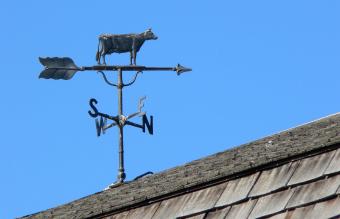
If you live in what we rural folks affectionately call the sticks, you've probably come across a rusted-up weathervane atop a barn once or twice. Antique weathervanes represent an often overlooked part of American history, one steeped in amateur expression by the common people. Much like barn quilts, these unique fixtures of the American landscape have their charm and often outperform expectations at auction.
Antique Weathervanes That Soared to the Top of the Auction Block
Sure, that crusty dusty weathervane stuck on top of your great-great grandfather's barn isn't much to look at, but with a little TLC, it might soar to the top of the auction block. Antique weathervanes — as important pieces of American folk art and rural history — can go for thousands, even in poor condition. Of course, the hammer price depends on the motifs present, the materials, the makers, and the age.
| Antique Weathervane | Sales Price |
|---|---|
| JR Mott Ironworks Indigenous Archer | $5.8 million |
| 1910 Open Touring Car | $941,000 |
| 1870s Fire Pumpe & Double-Horse | $437,500 |
In the mid-2000s, a full-sized antique weathervane depicting an indigenous archer with an impressive headdress from JR Mott Ironworks sold for a shocking $5.8 million.
Another full-bodied weathervane that performed well at auction was the Open Touring Car from 1910 which sold for $941,000 100 years later.
While size was a key factor in the $5.8 million price tag, detail was the selling point for this sheet-copper fire pumper and double-horse weathervane from the 1870s. It sold for $437,500.
Weathervanes aren't a uniquely American artifact with extant examples stretching back to Ancient Greece.
Common Historic Weathervane Manufacturers
Weathervanes come in all sorts of shapes and sizes, though they typically share a green tinge from the commonly used sheet copper. Whether painted or bare, iron or zinc, antique weathervanes were once a hot commodity, and these are a few of the more notable American companies that produced them:
- J Harris & Co, Boston, MA
- JW Fiske, New York, NY
- Jewell & Co, Waltham, MA
- Cushing & White (or LW Cushing & Sons), Waltham, MA
- J Howard, West Bridgewater, MA
- Dempster Mill Manufacturing Company, Beatrice, NE
In 1716, Shem Drowne created the first American weathervane — a copper archer — for the Province House in Boston, Massachusetts.
Related: Hobo Nickels: The Folk Art Tradition You've Never Heard Of
Weathervane Manufacturers With Known Maker's Marks
Well-known weathervane manufacturers during the 1800s, especially the latter decades, included markings or their names on their products.
A few of the most notable manufacturers that used markings or their company name on weathervanes include:
- Cushing and White
- EG Washburne & Co
- Harris and Company
- J Howard and Company
- JR Mott and Company
- JW Fiske Iron Works
- LW Cushing and Sons
- Rochester Iron Works
Popular Antique Weathervane Motifs to Spot

When it comes to American weathervane motifs, it's a case of what you won't find versus what will find. Early artisans drew inspiration from their daily life, but generic motifs grew into highly detailed renderings of complex machinery and portraiture over time.
Some antique weathervane motifs include:
- Archers
- Arrows
- Birds
- Cars
- Cows
- Fish
- Flags
- Heralds
- Horses
- Insects
- Jockeys
- Pigs
- Pigs
- Roosters
- Ships
Related: Discover Andrew Clemens's Intricate Sand-in-a-Bottle Folk Art
Common Weathervane Materials to Watch For

Some of the most commonly used materials for manufacturing weathervanes include aluminum, tin, zinc, and iron. These metal weathervanes are typically less expensive than copper, brass, and steel ones. Wood weathervanes have also been found and were usually given a hand-painted finish. In rare cases, weathervanes even featured gold gilding.
When assessing an old weathervane, look for:
- Patina: Copper weathervanes acquire a patina finish over time.
- Rust: Iron weathervanes oxidize and rust when exposed to the elements.
- Pitting: Iron weathervanes can also pit over time.
- Cracks: Wood weathervanes resemble driftwood as they age, bearing cracking and smoothing from the weather.
Antique weathervanes with their original finish — no matter how degraded — perform better than those that have been refinished or restored.
Common Art Doesn't Equal Common Prices
Antique weathervanes fall into that unique category of common artifacts that are worth way more than you'd expect. The mundane does equal money in some cases. So, the next time you peruse that air-conditioner-less antiques store off the highway, keep your eyes peeled for one of these hometown heroes.







